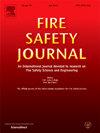Digitized fuel load survey in commercial and university office buildings for fire safety assessment
IF 3.4
3区 工程技术
Q2 ENGINEERING, CIVIL
引用次数: 0
Abstract
Fuel load significantly affects fire development in compartments, and its design value derives from the statistical results of numerous surveys. This work enhances the fuel load database by employing a digitized survey method to assess 27 university and commercial offices in Hong Kong and Mainland, China. The results revealed significant differences in fuel load densities: university offices averaged 382 MJ/m2 (SD: 297 MJ/m2) and commercial offices averaged 1804 MJ/m2 (SD: 1319 MJ/m2). Moreover, it proposed an online questionnaire method to overcome onsite access limitations. Furthermore, it identified higher fuel load densities in commercial offices due to higher paper-made content and greater occupancy density than university offices. The fuel load of university offices was lower than that in previous surveys and design codes, while commercial fuel load was higher. Notably, there is an increasing tendency of fuel load density and plastic combustible composition over the years. Additionally, it considers that Gompertz distribution better fits cumulative probabilities of fuel load density data with a small sample size. Overall, it provides a valuable database for future fire scenario design, fire codes edition, and fire safety assessment and discusses future collaboration with AI applications.
用于消防安全评估的商业和大学办公楼数字化燃料负荷调查
燃料负荷对隔间的火灾发展有重大影响,其设计价值来自大量调查的统计结果。这项研究采用数字化调查方法,对香港和中国大陆的 27 所大学和商业办公室进行了评估,从而增强了燃料负荷数据库。结果显示了燃料负荷密度的显著差异:大学办公室平均为 382 兆焦耳/平方米(标准差:297 兆焦耳/平方米),商业办公室平均为 1804 兆焦耳/平方米(标准差:1319 兆焦耳/平方米)。此外,它还提出了一种在线问卷调查方法,以克服现场访问的限制。此外,研究还发现,与大学办公室相比,商业办公室的燃料负荷密度较高,原因是纸张含量较高,占用密度较大。与以往的调查和设计规范相比,大学办公室的燃料负荷较低,而商业办公室的燃料负荷较高。值得注意的是,燃料负荷密度和塑料可燃物成分有逐年增加的趋势。此外,该研究还认为,在样本量较小的情况下,Gompertz 分布更适合燃料负荷密度数据的累积概率。总之,它为未来的火灾场景设计、消防法规修订和消防安全评估提供了一个宝贵的数据库,并探讨了未来与人工智能应用的合作。
本文章由计算机程序翻译,如有差异,请以英文原文为准。
求助全文
约1分钟内获得全文
求助全文
来源期刊

Fire Safety Journal
工程技术-材料科学:综合
CiteScore
5.70
自引率
9.70%
发文量
153
审稿时长
60 days
期刊介绍:
Fire Safety Journal is the leading publication dealing with all aspects of fire safety engineering. Its scope is purposefully wide, as it is deemed important to encourage papers from all sources within this multidisciplinary subject, thus providing a forum for its further development as a distinct engineering discipline. This is an essential step towards gaining a status equal to that enjoyed by the other engineering disciplines.
 求助内容:
求助内容: 应助结果提醒方式:
应助结果提醒方式:


